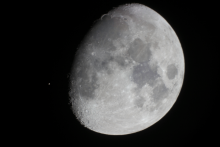Listen to today's episode of StarDate on the web the same day it airs in high-quality streaming audio without any extra ads or announcements. Choose a $8 one-month pass, or listen every day for a year for just $30.
You are here
Moon and Aldebaran
It’s a bit hard to believe when you look at it, but we’re not seeing the star Aldebaran at its best.
Aldebaran stands to the lower right of the Moon this evening. It shines brightly even through the lunar glare. In fact, it’s the 14th-brightest star system in the night sky, so it’s always easy to spot.
At visible wavelengths, Aldebaran shines about 150 times brighter than the Sun. That’s mainly because the star is much bigger than the Sun, so there’s a lot more surface area to radiate light into space.
When you add up all wavelengths of light, though, Aldebaran is about 450 times brighter than the Sun. Most of that energy is in the infrared, which is invisible to the human eye.
That, too, is a result of Aldebaran’s great size. The star is nearing the end of its life, causing its outer layers to puff up to giant proportions. As those layers expanded, they also got cooler — much cooler than the Sun. That lower temperature gives Aldebaran its orange color — cooler stars are orange or red, while hotter ones are blue or white.
Cooler stars radiate most of their energy at wavelengths beyond the red end of the visible spectrum — the infrared. And that’s the case with Aldebaran. Earth’s atmosphere absorbs most infrared energy from stars. But from outside the atmosphere, if our eyes were tuned to the infrared, Aldebaran would look even brighter than it does now. Only then would we see this bright star at its absolute best.
Script by Damond Benningfield



